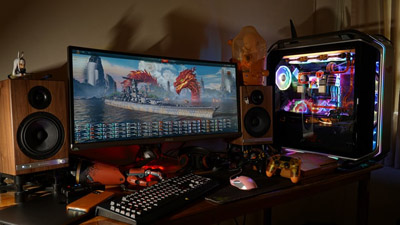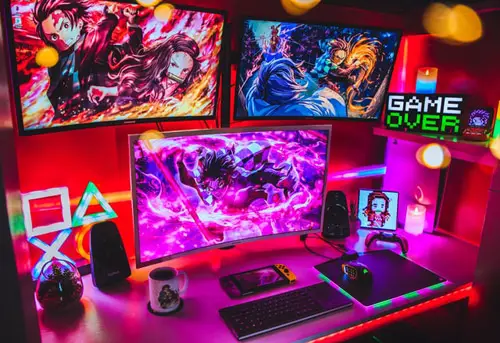
The best AMD Radeon settings are a combination of graphical and visual features available in the AMD Radeon Software.
While AMD's default driver settings offer a great mix of performance and aesthetics, you're missing out on an optimal gaming experience if you don't use the advanced control options provided in the AMD Radeon settings.
I've dug deep into this tool and put together the best settings that move the needle in terms of helping you achieve both higher FPS and better visuals.
All the optimizations suggested in this article are 100% software-based and completely safe to do. We promise you won't burn your mobo in the process.
Contents
Before you tweak anything in the AMD Radeon software settings, make sure to check the following:
Both these options are crucial to fixing any driver-related issues or random stutter problems.
Once you've done that, the following sections will explain how you can improve your AMD Radeon performance.
Let's first optimize the 3D graphics settings. To access these, open AMD Radeon Settings and navigate to the Gaming tab.
You can choose to edit Global Graphics or Game Graphics. Any changes made via the latter will only apply to specific games, but for now, we'll optimize the Global Graphics settings.
Now you should see different pre-defined profiles provided by AMD (Gaming, eSports, etc.). You can select any of them to begin with but our favorite is the eSports profile.
Once you've selected a profile, you can now see a list of features that are explained below:
The Radeon Anti-Lag feature reduces input lag, which is the delay between the output to appear on screen after the game samples the user input.
Keep this Enabled
You'll see the best effect at lower FPS ranges (<100) but it's still useful at higher frame rates. It's super-effective to reduce input lag in PvP games.
Radeon Chill is an adaptive refresh rate feature. It dynamically regulates the frame rate based on your in-game activity.
Here's the deal:
With Chill ON you'll be saving on some power, but at the same time, you might face some stutters if your FPS jumps around a lot.
But we've found the perfect solution to that - Enable Chill, set the Max FPS to the highest FPS you think you'll ever need in a game, and set the Min FPS to the lowest value you'll be okay with.
This way not only your GPU and CPU will run cooler, but you don't have to worry about visual glitches or stutters.
Radeon Boost lowers game resolution according to on-screen motion. If you're playing a heavy fast-paced game, this can give a decent push to FPS.
We recommend Enabling it on lower-end PCs or a laptop, as you probably won't see a noticeable improvement on a high-end machine.
Radeon Image Sharpening (RIS) is one of our favorite features. It enhances image quality by applying a sharpness filter to objects, for very little performance cost.
Definitely Enable it.
The ideal Sharpness value depends on your needs.
Here's what we suggest: If you have an inexpensive monitor that's probably on the softer side, you can use a higher value (70 - 80%). But for high-end monitors, you can work with a lower value with the sweet spot being somewhere around 30 - 50%.
Also, if you don't want RIS to be active on your computer all the time, you might want to try enabling RIS only for specific games (by going into Game Graphics).
Enhanced Sync (and Vertical Refresh) is basically AMD's way of doing V Sync, and we recommend you keep this disabled. Also, set the 'Wait for Vertical Refresh' option to 'Always off' as well.
It's only really useful if you're experiencing a lot of screen-tearing issues with a certain game. But most of the time, it's going to impact performance negatively by increasing input lag and reducing the smoothness of your gameplay.

Once you've configured the general graphics options, you can move on to optimizing advanced 3D options by clicking on the 'Advanced' arrow. Here are the recommended advanced application settings for AMD Radeon software:
In simple terms, Anti-Aliasing (AA) reduces jagged edges from textures. This results in a higher image quality at the cost of lower FPS.
You want to set this to Use application settings because you want whatever game you're playing to have full control over the Anti-Aliasing level.
You also have settings for choosing AA modes which will essentially tell the Radeon software about the intensity with which it will be applying AA to textures. Remember that these will only work if you've set AA to Enhance or Override.
There are three AA modes to choose from, with Multisampling being the least and Supersampling the most graphically demanding.
Bedsides the Anti-Aliasing mode feature, AMD provides Morphological Filtering which is a shader-based post process AA technique. You can use this alongside the 3 AA methods mentioned above. AMD claims that the Morphological Filtering Anti-Aliasing mode has a lower impact on performance than other modes.
If you're not using AMD Radeon software to do Anti-Aliasing for you, don't worry about these options. But if you are, then choose them purely based on your personal needs and GPU.
Anisotropic Filtering is much like AA, but it applies to textures that are far away or at odd angles (think roads & trees).
Set the Anisotropic Filtering level according to your GPU capabilities as it does come with a performance hit. If you need a higher visual quality, you can use a higher setting. For an ideal balance between performance and image quality, use a middle-ground setting like 2x or 4x.
Texture Filtering Quality changes the quality of 3D graphics. This feature has probably the least impact on visuals so keep it on Standard.
Surface Format Optimization is another setting that has little-to-no impact on games. But AMD claims that it might improve performance and lower VRAM usage, so just bank on them and leave it Enabled.
Tessellation Mode enhances object details by adding additional polygons during the rendering process.
We recommend using AMD optimized or Override application settings.
For best performance, select Override application settings and limit the level of tessellation to a low value (or even turn it OFF). Setting the Maximum Tessellation Level to a large value (such as x32 or x64) should improve image quality but it comes with a hefty performance cost.
OpenGL Triple Buffering is another cousin of VSync but it works with OpenGL API applications. Just Disable it.
Also, note that this feature requires 'Wait For Vertical Refresh' to be always on.
Shader Cache stores frequently used game shaders locally which helps in reduced CPU usage and faster load times.
You should empty this cache occasionally to free up used space and allow for fresh cache files to be generated.

We're done with the performance side of things. Let's quickly look at the more aesthetic side of AMD software in this section.
Switch over to the Display tab that's right next to the Graphics tab in the AMD Radeon settings. Here are the main features you need to know:
While we suggested keeping Enhanced Sync disabled, AMD FreeSync is something that you SHOULD be using.
FreeSync dynamically adapts your monitor's refresh rate to match that of your game (whereas VSync takes the opposite tack, forcing your GPU to match your monitor's rate).
If you have an AMD FreeSync supported monitor, then you're missing out on the frame rate optimization and almost zero screen-tearing if you don't use it.
Now if you have a high-end GPU, you'll love the Virtual Super Resolution feature.
Suppose you have a 1080p monitor. This setting will allow you to use 4K resolution for your game and then scale it down to your monitor's resolution. This produces super-crisp visuals but with a hit on FPS.
Whether you should use this setting depends on your GPU and if you really need that extra-sharp image quality.
GPU Scaling will allow applications that require a specific aspect ratio, to adjust and fit to a different aspect ratio.
You can use three different configurations depending on what you want:
Set according to your preferred option.
The Color settings are solely for aesthetics. These won't affect FPS or performance in any major way.
In short, you can use them to adjust visual quality without worrying about any effect on performance. A lot of streamers use these settings to make their game look as pleasing as possible.
Try changing the brightness, contrast, sharpness, and other color options to see what works for you.
Well, that was a lot of actions to perform in a single day!
Or maybe not?
Once you configure the best AMD Radeon settings on your PC and realize that you're playing a whole new game, it'll all be more than worth it.
That's all for now. Hope you liked this guide!
